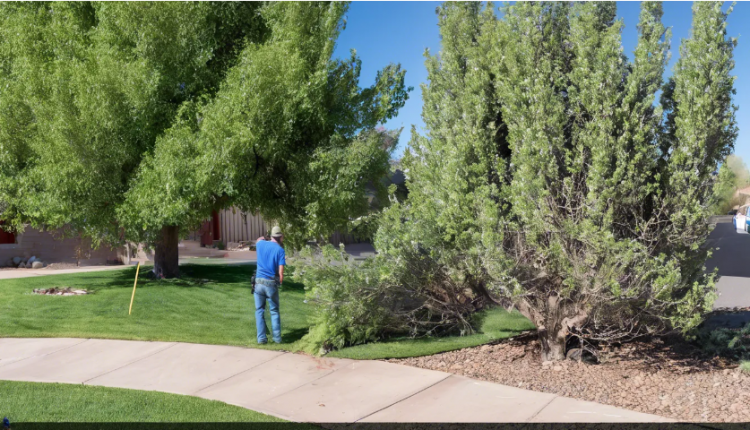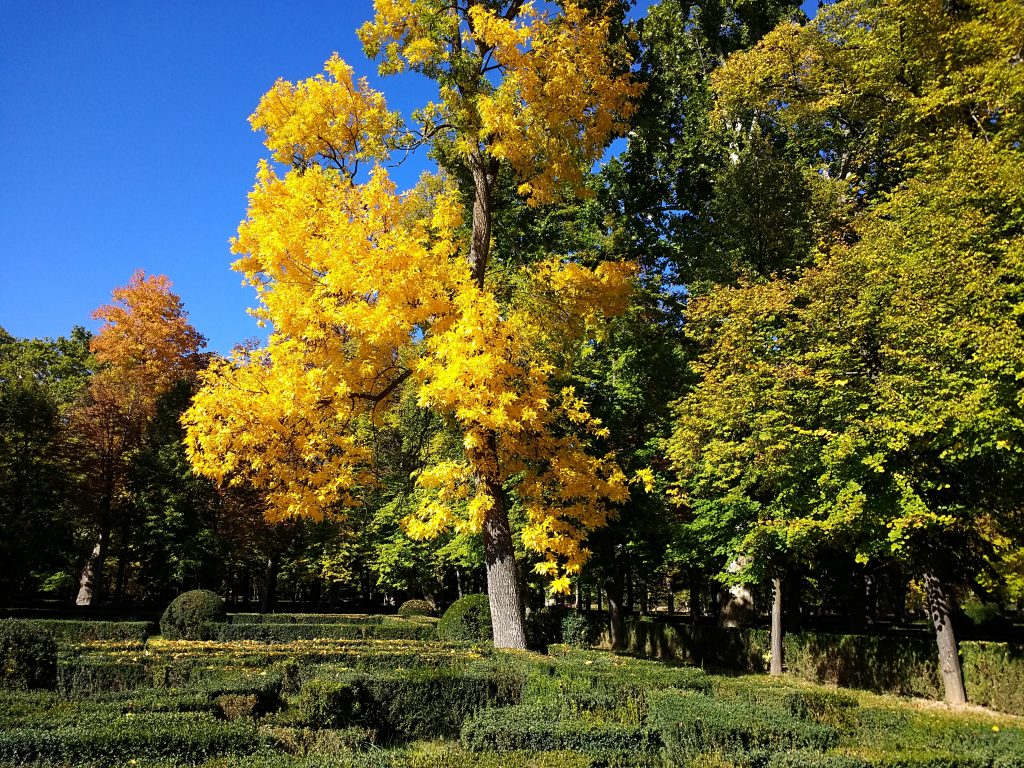
Infrastructure is often thought of as the roads, power lines, water systems, schools or hospitals that support and improve human settlement. This is known as gray infrastructure.
For gray infrastructure to function, there has to be connectivity. The highways need to be connected to side streets, and utilities needs to be connected to residential areas so people have access to electricity and water.
Green infrastructure is applying these same concepts of connectivity to trees and the natural system. While much of the information available refers to stormwater management, it can actually be a holistic or strategic approach that addresses the economic and social impacts of sprawl and fragmented land.
Trees in both rural and urban areas are an important part of green infrastructure. Individual trees, and small or large green spaces, as well as natural areas, sustain clean air and water, reduce soil erosion, provide wildlife habitat, and numerous other benefits. Trees provide clean air and water, provide shade which cools parking lots and buildings, mitigate storm water run-off effects, and increase real estate values.
In today’s urban environments, the use of trees as natural green infrastructure has gained significant recognition. Trees offer numerous benefits beyond their aesthetic appeal. They serve as essential components of green infrastructure, providing a wide range of environmental, social, and economic advantages. This note explores the benefits of utilizing trees as natural green infrastructure.

- Stormwater Management: Trees play a crucial role in managing stormwater runoff. Their canopies intercept rainfall, reducing the amount of water that reaches the ground. Tree roots absorb and store excess water, decreasing the strain on stormwater management systems. By slowing down runoff and promoting infiltration, trees help prevent flooding, erosion, and water pollution.
- Air Quality Improvement: Trees act as natural air filters, removing pollutants and improving air quality. Through a process called photosynthesis, trees absorb carbon dioxide and release oxygen, reducing the levels of greenhouse gases in the atmosphere. Additionally, their leaves capture airborne particulates and absorb harmful pollutants, contributing to cleaner and healthier air for communities.
- Heat Island Mitigation: Trees provide shade, which helps to mitigate the urban heat island effect. The shade from tree canopies reduces surface temperatures and lowers energy demand for cooling buildings. By creating cooler microclimates, trees enhance comfort levels for pedestrians and reduce the overall energy consumption of urban areas.
- Biodiversity Support: Trees provide habitat for various species, contributing to biodiversity preservation. They offer food, shelter, and nesting sites for birds, insects, and small mammals. By incorporating a diverse range of tree species, urban green spaces can support thriving ecosystems and enhance local biodiversity.
- Noise Reduction: Trees have the ability to absorb and deflect sound, acting as natural noise barriers. Their leaves, branches, and trunks absorb and scatter sound waves, reducing noise pollution in urban environments. Strategic placement of trees near roads, highways, and noisy areas can effectively mitigate noise levels and create more peaceful surroundings.
- Enhanced Mental Health and Well-being: Exposure to green spaces, including tree-lined streets and parks, has been linked to improved mental health and well-being. Trees and greenery have a calming effect, reducing stress, anxiety, and depression. They provide visual appeal and contribute to a sense of tranquility, promoting recreational activities and enhancing the overall quality of life for communities.
- Economic Benefits: Trees as green infrastructure generate economic benefits for communities. They increase property values, making neighborhoods more desirable and attractive to potential buyers. Trees also reduce energy costs by providing shade, resulting in lower cooling expenses for buildings. Furthermore, the presence of green spaces with trees attracts tourism, boosts local businesses, and enhances economic development.
Utilizing trees as natural green infrastructure offers multifaceted benefits for communities. They provide stormwater management, improve air quality, mitigate heat island effects, support biodiversity, reduce noise pollution, enhance mental well-being, and generate economic value. By incorporating trees into urban planning and development, communities can create sustainable, resilient, and vibrant environments that prioritize human and environmental health. Embracing trees as natural green infrastructure is a valuable investment in the long-term sustainability and livability of our cities and towns.
Why is Green Infrastructure Important?
Green space or open space is often thought of as isolated parks or recreational areas and is viewed as self-sustaining, or something “nice to have”, or as vacant land simply not yet developed. But to function effectively, green infrastructure must be managed. More importantly, planned and managed green infrastructure systems mitigate the need for expensive grey infrastructure installations.
Managing green infrastructure effectively recognizes that development and growth are inevitable and necessary, but the pattern of that growth, its location, form, and intensity can be directed and managed to reduce negative impacts. Developing long range strategies to incorporate natural areas and green spaces into land use planning, especially in the early stages would maximize the impact and effectiveness of all infrastructure (economic and environmental).
Water Quality and Quantity
Water Quality: Stormwater runoff from urban areas delivers pollutants— including pathogens, nutrients, sediment, and heavy metals—to our streams, lakes, and beaches. In cities with combined sewer systems, high stormwater flows also can send untreated sewage into our waters. By retaining rainfall from small storms, green infrastructure reduces stormwater discharges. Lower discharge volumes translate into reduced combined sewer overflows and lower pollutant loads. Green infrastructure also treats stormwater that is not retained.
Flooding: Conventional stormwater infrastructure quickly drains stormwater to rivers and streams, increasing peak flows and flood risk. Green infrastructure can mitigate flood risk by slowing and reducing stormwater discharges.
Water Supply: Rainwater harvesting and infiltration-based practices increase the efficiency of our water supply system.
- Water collected in rainwater harvesting systems can be used for outdoor irrigation and some indoor uses and can significantly reduce municipal water use.
- Water infiltrated into the soil can recharge ground water, an important source of water in the United States.
![]()
Private and Public Cost Savings: Basing stormwater management systems on green infrastructure rather than on gray infrastructure often results in lower capital costs for developers. The savings result from lower costs for:
- site grading, paving, and landscaping; and
- smaller or eliminated piping and detention facilities.
In cities with combined sewer systems:
- green infrastructure controls can cost less than conventional controls ; and
- green-gray approaches can reduce public expenditures on stormwater infrastructure.
Air Quality
Ground-Level Ozone: When nitrogen oxides and volatile organic compounds interact in the presence of heat and sunlight, they create ground-level ozone or “smog.” Smog conditions are usually worst in the summer and can lead to respiratory health problems. Vegetation can reduce smog by
- reducing air temperatures,
- reducing power plant emissions associated with air conditioning, and
- removing air pollutants
Particulate Pollution: The tiny bits of dust, chemicals, and metals suspended in the air we breathe are called particulate matter. It can enter our lungs and cause serious health effects. Trees, parks, and other green infrastructure features can reduce particulate pollution by absorbing and filtering particulate matter.
Health Effects: Breathing smog and particulate pollution can cause respiratory ailments, including chest pain, coughing, aggravation of asthma, and even premature death. In their triple bottom line study on the benefits of green infrastructure, the city of Philadelphia found that increased tree canopy could reduce ozone and particulate pollution levels enough to significantly reduce mortality, hospital admissions, and work loss days.
Climate Resiliency
Communities across the country are feeling the effects of climate change right now. Depending on where a community is located, climate change poses different threats to critical infrastructure, water quality, and human health. Fortunately, green infrastructure can help communities become more resilient to the impact of climate change.
Habitat and Wildlife
Habitat Improvement: Vegetation in the urban environment provides habitat for birds, mammals, amphibians, reptiles, and insects. Even small patches of vegetation like green roofs can provide habitat for a variety of insects and birds. By reducing erosion and sedimentation, green infrastructure also improves habitat in small streams and washes.
Habitat Connectivity: Large-scale green infrastructure, such as parks and urban forests, help to facilitate wildlife movement and connect wildlife populations between habitats. Learn how Loxahatchee, Florida, is protecting the local watershed and conserving native ecosystems through the Loxahatchee Regional Greenways System.
Communities
Green Jobs: Green infrastructure can reduce a community’s infrastructure costs, promote economic growth, and create construction and maintenance jobs. As demand for green infrastructure skills increases, a range of new training and certification programs is emerging.
Health Benefits: More green space and parks encourage outdoor physical activity, reducing obesity and preventing associated chronic diseases, such as heart disease, high blood pressure, stroke, Type II diabetes, arthritis, and certain kinds of cancer.
Recreation Space: Vegetation and trees can increase publicly available recreation areas, allowing urban residents to enjoy greenery without leaving the city. Additionally, vegetation and permeable pavements can reduce noise pollution by damping traffic, train, and plane noise.
Property Values: Using green infrastructure in construction and increasing vegetation and tree cover can increase property values, benefiting both developers and homeowners.
What does Green Infrastructure look like?
Management of the green infrastructure takes planning. But it can be managed at different levels or scales for a variety of objectives, which allows it to be flexible and adjustable to the needs of current development.
Green infrastructure systems can be:
- Protected watersheds that decrease the need for man-made water treatment facilities.
- Reforested slopes that help control flooding events and landslides.
- Protected waterways that prevent soil erosion, improve water quality, and provide wildlife habitat corridors.
- Planted swales or detention ponds that absorb and filter storm water run-off.
- Semi-porous paving stones that decrease direct storm water run-off from parking lots.
- Private forest land that protects water quality, provides wildlife habitat, and increases ecosystem biodiversity.
- Parks and greenways connecting through neighborhoods, improves air quality and habitat.
- Canopy cover in and around housing developments, decrease stormwater runoff and improve water quality entering local water bodies.
- Street trees, healthy and undamaged, provide shade and reduce the heat island effect.
If you need a tree service in Utah, you can call:
Truco Services, Inc.
4640 Commerce Drive
Murray, Utah 84107
(801) 466–8044
https://truetreeservices.com/



Comments are closed.